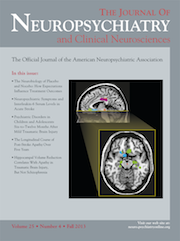How Heterogeneous Can the Clinical Presentation for Creutzfeldt-Jacob Disease Be?
To the Editor: Creutzfeldt-Jakob disease (CJD) is a heterogeneous clinical condition, usually presenting in a sporadic form (sCJD) and affecting about 0.5–1.5 cases per million inhabitants, showing particularities on pathological and clinical features, according to western blot analysis of Prion scrapie protein (PrPsc).1
A clinical case published in this journal recently reported the unusual association of CJD and catatonia.2 Others reports are also showing that psychiatric symptoms, such as depression, are more common than previously assumed.3
There is a current interest in reporting a more detailed clinical profile of patients with prion disorders, and this is crucial to increasing the rate of early detection.
The most recent cases reported in our institution reinforce this concept; here, we summarize four cases confirmed in Recife, a major city (about 1.5 million people) in northeastern Brazil.
Histopathological and imuno-histochemistry assays confirmed CJD; Cases #3 and #4 were MM at 129 codon in the PRNP gene, and no mutations were observed. Table 1 summarizes the major symptoms and profiles of each case.
| Case | Age, years | Gender | Illness Duration, months | Major Characteristics | Magnetic Resonance Imaging | 14–3–3 Protein |
|---|---|---|---|---|---|---|
| #1 | 62 | M | 7 | Visual impairment; delirium; cerebellar syndrome; axial and appendicular ataxia | Increase of ventricular volume | + |
| #2 | 62 | F | 4 | Behavioral disturbance; hallucinations; extrapyramidal syndrome | Bilateral hypersignal in parietal and occipital cortex | Not performed |
| #3 | 65 | M | 8 | Seizures; trismus; behavioral changes; pyramidal signs; myoclonus | Hypersignal in T2 and Flair; diffuse atrophy; basal ganglia affected | — |
| #4 | 52 | M | 6 | Motor impairment; myoclonus; dysphagia; pyramidal signs | Hypersignal in T2 and Flair; diffuse atrophy; basal ganglia affected; frontal and parietal damage | + |
Patient #1 was admitted to the hospital service because of delusions and behavioral changes, but diplopia followed by cognitive impairment, characterized by progressive memory decline, were retrospectively mentioned by relatives several weeks before. In the ‘70s, this patient had had neurosurgery for a pituitary adenoma in the United States. Neuro-ophthalmologic evaluation showed a mild palsy in the sixth nerve.
Case #2 was hospitalized in 2009, but medical records report depressive symptoms 2 years before, with sudden psychomotor agitation, aggression, and hallucinations, and the patient’s being hospitalized in the psychiatric clinic. Confusion and aggression increased progressively, associated with intense hypertonia in all four limbs and neck, with later feeding impairment.
Curiously, the first and second cases died on the same day, and this brought about major concern of local sanitary authorities and general media.
Relatives of Patient #3 reported disorientation, memory loss, and behavior changes characterized by disinhibition. There is a history of neuropsychiatric illness in his family. He presented with myoclonia, apraxia, and acute weight loss.
The last and most recently reported case was a 52-year-old man. The first complaints were changes in sleeping pattern, dizziness with imbalance, ataxia, and myoclonia. This was another patient with a familial history of mood disorder, but not associated with prion diseases. This patient also presented difficulty in communication and comprehension of simple commands.
Brazil has a recent history of epidemiological surveillance for prion disorders, and, since 2005, we have dealt with the challenge to make compulsory notification a reality, still far from the optimal expected number of annual reports for a country with almost 200 million inhabitants.
Martins et al.4 confirmed the high spectrum phenotype of this disease in Brazil and other countries are possibly due also to ethnic influences.
Brazil’s examples highlight the importance of additional attention for possible CJD cases starting with behavioral changes. Neurologists should be attentive to more atypical symptoms, and CJD must be a differential diagnosis in rapidly-progressive dementia when neurodegenerative, infectious, and others syndromes was suspected.5
1 : Phenotypic variability in human prion diseases. Neuropathol Appl Neurobiol 2005; 31:565–579; available from http://www.ncbi.nlm.nih.gov/pubmed/16281905Google Scholar
2 : New variant Creutzfeldt-Jacob disease presenting with catatonia: a rare presentation. J Neuropsychiatry Clin Neurosci 2012; 24:E51–E53Link, Google Scholar
3 : Depressive disorder with psychotic symptoms as psychiatric presentation of sporadic Creutzfeldt-Jakob disease: a case report.Google Scholar
4 : Prion diseases are under compulsory notification in Brazil: surveillance of cases evaluated by biochemical and / or genetic markers from 2005 to 2007. Dementia Neuropsychologia 2007; 1:347–355Crossref, Medline, Google Scholar
5 : Differential diagnosis of Creutzfeldt-Jakob disease. Arch Neurol 2012; Sept. (e-pub):1–5Google Scholar



